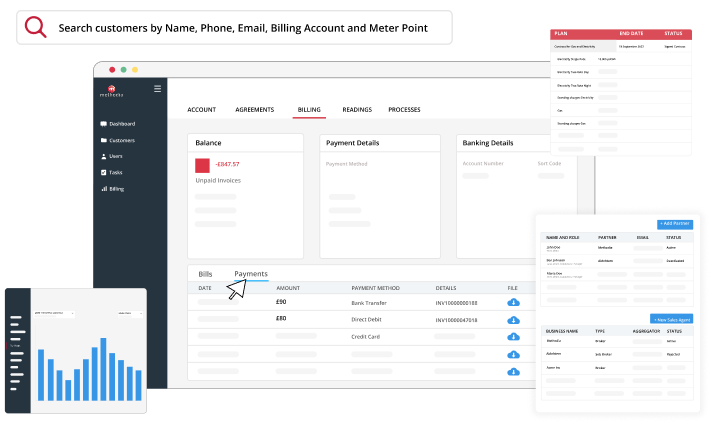Having worked in the utility sector for a while now, I’ve witnessed firsthand how the right billing software can transform operations, and how the wrong choice can create costly headaches. With the utility billing software market projected to reach over $14 billion in 2031, growing at approximately 10-12% annually, there’s never been more choice. However, more options means more confusion, so I’ve put together this guide based on my research and industry experience to help you navigate these waters.
Why Modern Utility Billing Software Matters
A while ago utility billing meant manual data entry and spreadsheet calculations. Those days are rapidly disappearing, and for a good reason. Modern utility billing software addresses critical challenges that our team see companies struggling with every day:
Automation and Accuracy: Manual processes are error-prone. I’ve seen billing disputes that could have been avoided with automated systems. With approximately 68% of utility providers now relying on software-based billing platforms, the industry has clearly moved toward digital solutions.
Real-Time Data Management: Smart meters and IoT connectivity have changed the game. Over 51% of current billing platforms support seamless integration with intelligent infrastructure, enabling real-time consumption tracking and dynamic pricing.
Regulatory Compliance: The compliance landscape is constantly evolving. Recent research data shows that nearly 59% of modern platforms are embedded with audit trails, encryption protocols, and compliance monitoring tools.
Financial Optimization: At the end of the day, streamlined billing means better cash flow and reduced operational costs. I’ve seen companies cut their billing cycle times in half with the right software.
Top Utility Billing Software Solutions for 2026
Let me walk you through the solutions I believe deserve your consideration, with pros and cons for each.
Methodia: A Comprehensive Utility Management Platform
Methodia is an end-to-end utility management solution. With nearly 2 decades of experience in serving energy retailers, utility companies, and telecom providers. The platform addresses the complete customer lifecycle, from acquisition through billing to retention.

Pros:
True All-in-One Solution: What customers appreciate most is that Methodia integrates CRM, billing, asset management, business process management, and customer self-service portals into one ecosystem. No more juggling multiple software licenses or dealing with integration headaches.
Multi-Utility Flexibility: Whether you’re managing electricity, gas, water, or bundled services, Methodia handles everything from one platform. Something that can dramatically simplify operations for multi-utility providers.
Sophisticated Billing Engine: The platform supports bulk, live, and ad-hoc billing with advanced features including time-of-use pricing, tariff management, and automated invoice generation. The real-time billing capability is particularly valuable for companies wanting to provide immediate invoices after meter readings.
Scales With Your Business: From SMEs entering deregulated markets to large industrial suppliers, Methodia’s modular architecture grows with you. The cloud-based deployment means easy onboarding without massive technical overhead.
Renewable Energy Ready: For companies in the clean energy space, Methodia provides billing for distributed energy resources, dynamic pricing, and prosumer management—features that are increasingly critical.
White-Label Capabilities: Non-utility companies can leverage Methodia to enter the energy market without building infrastructure from scratch.
Potential Drawbacks & Constraints: With so many features, there’s inevitably a learning curve for staff. The comprehensive nature that makes it powerful can feel overwhelming initially.Also, if you’re running a very small utility with simple billing needs, some of Methodia’s advanced features might be more than you need.
Oracle Utilities
As the market leader, Oracle Utilities is the 800-pound gorilla in this space. Its global footprint makes it a default choice for many large, complex utilities that need enterprise-grade reliability and scalability. However, that scale often comes with longer implementation cycles, higher total cost of ownership, and a level of complexity that may be excessive.
Pros:
Enterprise-Grade Reliability: Oracle’s reputation for robust, scalable solutions is well-earned. If you’re a large utility handling millions of customers, this is built for you.
Comprehensive Analytics: The reporting and analytics capabilities are top-tier, providing deep insights into operations and customer behavior.
Extensive Integration: Oracle’s ecosystem means you can connect with virtually any other enterprise system you’re running.
Global Support Network: With a massive customer base comes extensive support resources and a large community of users.
Potential Drawbacks & Constraints:
Cost: Oracle solutions typically command premium pricing. For smaller utilities, this can be prohibitive.
Complexity: The platform’s power comes with complexity. Implementation can be lengthy and require specialized expertise.
Potentially Over-Engineered: If you don’t need enterprise-scale capabilities, you might be paying for features you’ll never use.
Less Agile: Large enterprise platforms can be slower to adapt to new market trends compared to more nimble competitors.
Kraken.tech
Kraken.tech is positioning itself as a modern, disruptive force in the utility technology space. Originating from the fast-growing energy retail sector, the platform focuses on highly automated operations and customer-centric service models that help utilities move faster.
Pros:
Cutting-Edge Automation: Designed to minimize manual processes, reducing overhead and improving operational efficiency.
Energy Transition Ready: Strong capabilities for managing renewables, time-of-use tariffs, and dynamic energy markets.
Customer-Centric Focus: Advanced tools for personalization, service transparency, and high-quality digital experiences.
Potential Drawbacks & Constraints:
Kraken.tech is primarily tailored to energy retailers and markets undergoing rapid deregulation. Utilities with broader operational needs, such as asset-intensive distribution or water/gas operations may find gaps that require additional platforms and deeper integrations to fully support their end-to-end business landscape.
Tridens Technology
Tridens offers a cloud-native billing solution that is particularly interesting for forward-thinking utilities. However, they are missing asset management, BPM and other important modules for utility companies which may require multiple integrations with other tools.
Pros:
Modern Architecture: The API-first, cloud-native design makes integration with other systems straightforward and future-proof.
Smart Grid Excellence: If you’re heavily invested in smart grid operations, renewable energy resources, and EV charging, Tridens shines here.
Customer Engagement Tools: The personalized offers and promotions engine is excellent for companies focused on customer retention.
Potential Drawbacks & Constraints: As mentioned in the beginning, they do not offer key modules for many utility companies such as asset management or BPM, which means utilities may still need additional systems and integrations to cover their full operational needs.
CIS Utility Billing by CUSI
CUSI is a long-established option in the utility software market, positioned firmly on the more traditional end of the spectrum. The product is built around tried-and-tested workflows that many utilities will find familiar, particularly those that have grown up on legacy on-premise or client–server systems.
Pros:
Proven Track Record: Almost 40 years in business speaks volumes about reliability and staying power.
Adaptable Workflows: The platform emphasizes flexibility in handling complex billing processes.
Extensive Experience: They’ve seen virtually every billing scenario and built solutions accordingly.
Potential Drawbacks & Constraints:
Traditional Interface: The user experience may feel outdated compared to newer, cloud-native solutions.
Modernization Concerns: Long-established platforms sometimes struggle to incorporate cutting-edge features as quickly as newer competitors.
Integration Challenges: Older architecture may require more effort to integrate with modern systems.
MuniBilling
MuniBilling positions itself as a cloud-based alternative in the utility billing landscape, focusing on simplicity, accessibility, and operational efficiency.
Pros:
Flexible Billing Engine: The system accommodates different tax rates, fees, and adjustable billing tiers for metered and non-metered bills.
User-Friendly: The interface is intuitive, reducing training time for staff.
Online Customer Portals: Good self-service options for customers reduce call center volume.
Potential Drawbacks & Constraints::
Scalability can become a concern for organizations expecting significant growth, as the platform may struggle to expand alongside rapidly evolving operational demands. Its feature set is also more limited compared to other platforms in the space, which could restrict advanced functionality needs over time. Additionally, it is not as well suited for utilities that manage multiple service types within a single environment.
Other Notable Solutions Worth Mentioning
The utility software market includes a growing number of providers that bring niche strengths, innovative approaches, or regional focus. These contenders are actively shaping the competitive landscape and earning adoption among utilities that want alternatives to the traditional heavyweights. These solutions stand out as examples worth monitoring and considering in the right context:
El Dorado Utility Billing
EnergyCap
Ferranti
Gentrack
Key Features to Consider While Evaluating
Based on years of experience, here’s what we always tell companies to prioritize:
Meter Management and Data Integration: The system must seamlessly handle data from various meter types. I’ve seen poor integration cause endless billing disputes.
Rate Management Flexibility: You need support for multiple rate structures: time-of-use pricing, tiered rates, contract-specific pricing. Markets evolve, and your software should adapt.
Automated Billing and Invoicing: Bulk billing, scheduled generation, and credit/debit note management should be seamless. Manual intervention should be the exception, not the rule.
Payment Processing: Multiple payment options with automated tracking are essential. Customers expect convenience, and you need efficient reconciliation.
Customer Self-Service: Web and mobile portals reduce call center volume while improving satisfaction. I consider this non-negotiable in 2026.
Analytics and Reporting: Real-time dashboards and customizable reports support strategic decision-making. Data should drive your operations.
Compliance and Security: Built-in regulatory tools, audit trails, and encryption protect both you and your customers.
Final Thoughts
After reviewing these options, I believe the transition to modern utility billing software is one of the most strategic investments you can make. The right platform improves operational efficiency, enhances customer satisfaction, and positions you competitively.
Whatever you choose, don’t rush the decision. Request demonstrations from your top choices, involve your billing team in the evaluation, and consider both immediate needs and five-year growth plans. The right billing software isn’t just about today, it’s about positioning your utility for long-term success.
We’ve seen companies transform their operations with the right choice and struggle for years with the wrong one. Do your homework, ask tough questions, and choose the platform that truly aligns with your vision for the future.
If you’d like to see how Methodia can support your goals, we’d be happy to walk you through a tailored demo when you’re ready.





